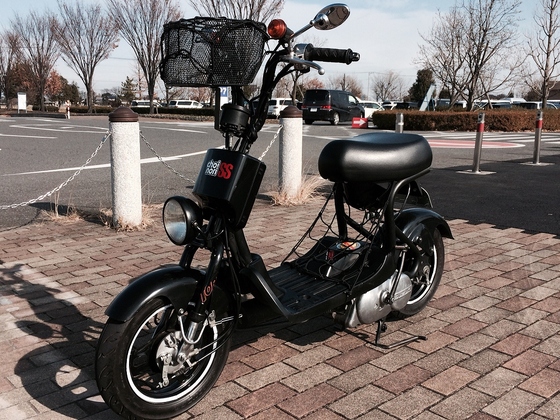The Suzuki Choi Nori was an interesting concept – a budget 49cc scooter for students and shoppers for short about town runs, with the added factor that it was going to be wholly made in Japan. In 2003, this was a major piece of marketing for a vehicle which retailed across its range from ~58,000 to 85,000yen on the road, whereas most ‘real’ 50ccs at the time started from 100,000yen (about 770 Euros or 660 GBP today).

That’s not even my assessment – that’s from their press release (available here in Japanese), where they also said they planned to sell 2,000 of these a month. Suzuki defined three main benefits for the scooter:
- Weighing in at less than 40Kg dry, and getting 76Km/litre it would be a highly economical and convenient machine at that price point.
- A cute design based around beautiful curves.
- Using a new lightweight engine.
I remember seeing them outside motorbike and even bicycle shops, in their bright colours and with their colourful adverts, along with the big red circle announcing they were Made in Japan. Even the name was cute, deriving from a phrase to mean ‘a short hop’.
The vehicle itself was basic to the point of it potentially seeming crude and yet the Society of Automotive Engineers of Japan listed it in their ‘240 Landmarks of Automotive Technology‘ where it sits in 2002. That’s some recognition for a scooter whose only rear suspension is the padding on the seat.
Why was it on that list then? It was probably due to the engine which was a four stroke aluminium unit, had a push rod design, and used a high speed plating process on its piston, simplifying the whole design and keeping that weight down.
They also managed to hit a price point with the more expensive Japanese labour compared to the South East Asian country rates where most small scooters were and are manufactured – and all Triumphs nowadays. That was an achievement, and is why it was a key part of the pitch – it wasn’t cheap parts – it was a clever design built with Japanese skill.
However, it wasn’t even two years into its eventual four year production run before that production was moved to from Japan to Taiwan, and before they stopped making them completely in 2007.
The more famous models were those with the distinctive and colourful ‘fenders’, and that’s that’s not painted metal or fibreglass either, it’s solidly moulded coloured plastic. They would later be removed on a second model called the Choi Nori SS which had a different headstock and handlebar design. It seems to lose something though over the original.

Looking on the auction sites now, there’s a ‘normal’ 2004 model with just 12Km on the clock with an asking price of 110,000yen. Most go in the 30,000-50,000yen range, but for a cheap 49cc which are all at least 13 years old, that’s not bad if you’re a seller. Is the Choi Nori a latent classic in the making? Is it the new Corgi? Who knows!
I’m somewhat curious to wonder if that was Suzuki’s plan all along – create a modern mini classic – dare I say a another Cub? No matter what their goals might have been, the plan lasted but a few years.
The dream lives on though, as there are indeed plenty on used auction sites, and a few fan groups remain such as http://www.suzuki-choinori.com/.
So what killed the ChoiNori? Sales? Not really since Suzuki claim they shifted 10 million of them, but more likely the old classic of an engine which needed investment to meet emissions standards, which in Japan were increasing, and it was unlikely it could hit Euro standards without R&D and which more critically would likely require a more complex engine design.
For me at least there would be another factor. In Japan, where there are a lot of slopes and I wonder if the Choi Nori could cut it and not just for power but the whole design.
I actually tried one out many years ago when I had a Honda Zoomer for around Tokyo as I liked scooters for inner city riding, albeit with the weird caveats that entails (which is a whole separate post). I’m not above also saying that the Choi Nori SS does look like a smaller, rounder Zoomer from some angles! All I really remember was that the Choi Nori didn’t like my bulk very much and felt more like a powered bicycle than a motorized anything. Also, that lack of rear suspension was not fun. The shop selling it said it was indeed being bought by students and people looking for cheap local transport which could be parked anywhere. I’d say it hit that target quite well.
That’s all a long time and quite a few kilograms ago for me though. Nowadays most electric assist bicycles cost more than the Choi Nori, so I wonder where it would fit in today’s world. Sales of 49cc scooters are still solid, perhaps better with higher petrol prices and social distancing, but that wasn’t the Choi Nori’s selling point, it was the price and the way it looked and what it did, but I do suspect the ‘hybrid electric’ bicycle owns that space now.
All that said, one of my goals once this COVID thing is in the (tiny) rear view mirror, is to get another ride on one and report back! I might even drop the fan club a mail and see if it’s still healthy.
Ride on Choi Nori!